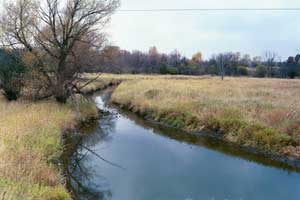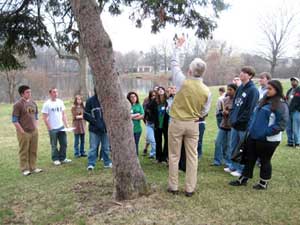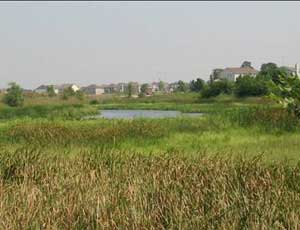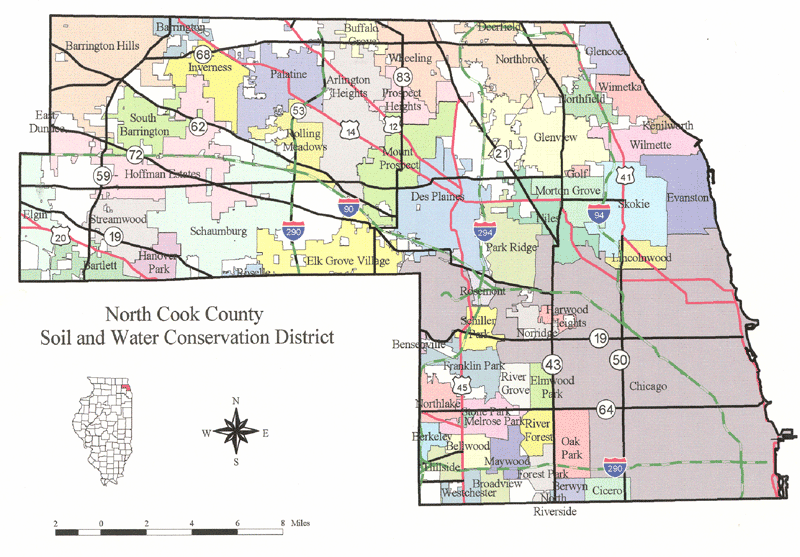
About NCCSWCD




The Soil and Water Conservation District Law was enacted July 7, 1937, by the United States Department of Agriculture. In December of 1946, Mr. Harold Bergman and Mr. Owen Maue secured the required signatures of landowners in several townships in Cook County to create a Soil and Water Conservation District for North Cook County. The list consisted of farmers between the ages of 25 and 45 who where public spirited and who wanted to bring the benefits of the USDA, Soil Conservation Service to Cook County.
At this time, they were able to get 738 signatures from the 1247 farms in North Cook County, a total of 59% of the landowners. On August 30, 1950, the State of Illinois, Office of the Secretary of State (Mr. Edward Barrett), issued a certificate of incorporation to the North Cook County Soil & Water Conservation District.
On November 7, 1950, the first election to organize our board of directors took place. Emil Hattendorf, Karl Rost, Henry Koehler, Herbert J. Mueller, and Wilmer Rohlwing became the first Board of Directors of the North Cook County Soil & Water Conservation District. These gentlemen were faced with erosion damage, lack of protective cover, and depletion of organic matter in the soil. Soil erosion and sediment control are still major concerns within the District. The North Cook County Soil & Water Conservation District is unique in that it has undergone a transition from a completely agricultural District to a District which is approximately 98% urban.
At this time, they were able to get 738 signatures from the 1247 farms in North Cook County, a total of 59% of the landowners. On August 30, 1950, the State of Illinois, Office of the Secretary of State (Mr. Edward Barrett), issued a certificate of incorporation to the North Cook County Soil & Water Conservation District.
On November 7, 1950, the first election to organize our board of directors took place. Emil Hattendorf, Karl Rost, Henry Koehler, Herbert J. Mueller, and Wilmer Rohlwing became the first Board of Directors of the North Cook County Soil & Water Conservation District. These gentlemen were faced with erosion damage, lack of protective cover, and depletion of organic matter in the soil. Soil erosion and sediment control are still major concerns within the District. The North Cook County Soil & Water Conservation District is unique in that it has undergone a transition from a completely agricultural District to a District which is approximately 98% urban.
Our Mission Statement
The mission of the North Cook County Soil and Water Conservation District is to provide information, education, and guidance in the conservation and wise use of natural resources within the District by:
1. Educating the public and encouraging local governments to plan, pass, and implement ordinances for protecting health, safety, and general welfare of the people of the District and its soil and water resources.
2. Work with all residents and units of government in protecting and increasing public lands.
3. Assist communities in understanding the need to identify, preserve, and enhance our natural communities of forests, savannas, prairies, and wetlands as well as areas that serve as important wildlife habitats.
4. Provide assistance in protecting the wetlands, lakes, and rivers in our communities from damage caused by point and non-point source pollution, flooding, erosion, and sediment.
1. Educating the public and encouraging local governments to plan, pass, and implement ordinances for protecting health, safety, and general welfare of the people of the District and its soil and water resources.
2. Work with all residents and units of government in protecting and increasing public lands.
3. Assist communities in understanding the need to identify, preserve, and enhance our natural communities of forests, savannas, prairies, and wetlands as well as areas that serve as important wildlife habitats.
4. Provide assistance in protecting the wetlands, lakes, and rivers in our communities from damage caused by point and non-point source pollution, flooding, erosion, and sediment.
WHAT IS A SOIL AND WATER CONSERVATION DISTRICT?
A Soil & Water Conservation District is a locally organized and operated public body; created by State Law for the purpose of promoting the protection and conservation of the District’s soil, water and related natural resources. The districts are organized in accordance with the provisions of Chapter 70 of the Illinois Compiled Statutes and are subject to the powers and restrictions as set forth in paragraphs 405/1 et seq.
Districts are:
1. legal subdivisions of state government, yet they are units of local government as well;
2. public bodies, corporate and politic, exercising public powers, with certificates of organization issued by the Secretary of State;
3. organized and operated under the provisions of Chapter 70 of the Illinois Compiled Statutes, (70 ILCS 405/1 et seq.
4. managed by Boards of Directors elected by landowners and occupiers within the district;
5. assisted by various agencies, organizations, and individuals in carrying out their responsibilities.
PRACTICAL DEFINITION OF AN SWCD
For most purposes, a district may be described as a locally organized and locally operated unit of government functioning under Illinois law, to promote protection, maintenance, improvement, and wise use of the soil, water, and related resources within the district.
A Soil & Water Conservation District is a locally organized and operated public body; created by State Law for the purpose of promoting the protection and conservation of the District’s soil, water and related natural resources. The districts are organized in accordance with the provisions of Chapter 70 of the Illinois Compiled Statutes and are subject to the powers and restrictions as set forth in paragraphs 405/1 et seq.
Districts are:
1. legal subdivisions of state government, yet they are units of local government as well;
2. public bodies, corporate and politic, exercising public powers, with certificates of organization issued by the Secretary of State;
3. organized and operated under the provisions of Chapter 70 of the Illinois Compiled Statutes, (70 ILCS 405/1 et seq.
4. managed by Boards of Directors elected by landowners and occupiers within the district;
5. assisted by various agencies, organizations, and individuals in carrying out their responsibilities.
PRACTICAL DEFINITION OF AN SWCD
For most purposes, a district may be described as a locally organized and locally operated unit of government functioning under Illinois law, to promote protection, maintenance, improvement, and wise use of the soil, water, and related resources within the district.
OUR DISTRICT's PURPOSE:
Currently, the primary functions of the North Cook Co. SWCD are:
• Providing technical assistance for the prevention of urban soil erosion, sedimentation and water quality degradation.
• Educating for the wise use of natural resources.
• Flood prevention.
• Conservation education.
• Encouraging responsible watershed planning through technical assistance.
• Landowner assistance and informational programs.
• Repository of historical documents needed for Phase I Environmental Reports, required to assess potential environmental hazards for future development.
There are 13 Townships in the District:
Barrington, Hanover, Elk Grove, Wheeling, Northfield, Maine, Palatine, Schaumburg, Niles, Leyden, Proviso, New Trier, Evanston
There are 60 Municipalities in the District:
Arlington Heights, Barrington*, Barrington Hills*, Bartlett*, Bellwood, Bensenville*, Berkeley, Berwyn*, Broadview*, Buffalo Grove*, Chicago*, Cicero*, Deerfield*, Des Plaines, East Dundee*, Elgin*, Elk Grove Village*, Elmwood Park, Evanston, Forest Park, Franklin Park , Glencoe, Glenview, Golf, Hanover Park*, Harwood Heights, Hillside, Hoffman Estates, Inverness, Kenilworth, Lincolnwood, Maywood, Melrose Park, Morton Grove, Mt. Prospect, Niles, Norridge, Northbrook, Northfield, Northlake, North Riverside*, Oak Park, Palatine, Park Ridge, Prospect Heights, River Forest, River Grove, Rolling Meadows, Roselle*, Rosemont, Schaumburg, Schiller Park, Skokie, South Barrington, Stone Park, Streamwood, Westchester*, Wheeling, Wilmette, Winnetka
*Some portion located outside of the county or District. The District is bound by the Cook Co. line to the north, west and east and by Cermak Ave. to the south.
Currently, the primary functions of the North Cook Co. SWCD are:
• Providing technical assistance for the prevention of urban soil erosion, sedimentation and water quality degradation.
• Educating for the wise use of natural resources.
• Flood prevention.
• Conservation education.
• Encouraging responsible watershed planning through technical assistance.
• Landowner assistance and informational programs.
• Repository of historical documents needed for Phase I Environmental Reports, required to assess potential environmental hazards for future development.
There are 13 Townships in the District:
Barrington, Hanover, Elk Grove, Wheeling, Northfield, Maine, Palatine, Schaumburg, Niles, Leyden, Proviso, New Trier, Evanston
There are 60 Municipalities in the District:
Arlington Heights, Barrington*, Barrington Hills*, Bartlett*, Bellwood, Bensenville*, Berkeley, Berwyn*, Broadview*, Buffalo Grove*, Chicago*, Cicero*, Deerfield*, Des Plaines, East Dundee*, Elgin*, Elk Grove Village*, Elmwood Park, Evanston, Forest Park, Franklin Park , Glencoe, Glenview, Golf, Hanover Park*, Harwood Heights, Hillside, Hoffman Estates, Inverness, Kenilworth, Lincolnwood, Maywood, Melrose Park, Morton Grove, Mt. Prospect, Niles, Norridge, Northbrook, Northfield, Northlake, North Riverside*, Oak Park, Palatine, Park Ridge, Prospect Heights, River Forest, River Grove, Rolling Meadows, Roselle*, Rosemont, Schaumburg, Schiller Park, Skokie, South Barrington, Stone Park, Streamwood, Westchester*, Wheeling, Wilmette, Winnetka
*Some portion located outside of the county or District. The District is bound by the Cook Co. line to the north, west and east and by Cermak Ave. to the south.

History
In the early 1930s, along with the greatest depression this nation ever experienced, came an equally unparalleled ecological disaster known as the Dust Bowl. Following a severe and sustained drought in the Great Plains, the region's soil began to erode and blow away; creating huge black dust storms that blotted out the sun and swallowed the countryside. Thousands of “dust refugees” left the black fog to seek better lives.But the storms stretched across the nation. They reached south to Texas and east to New York. Dust even sifted into the White House and onto the desk of President Franklin D. Roosevelt.
On Capitol Hill, while testifying about the erosion problem, soil scientist Hugh Hammond Bennett threw back the curtains to reveal a sky blackened by dust. Congress unanimously passed legislation declaring soil and water conservation a national policy and priority. Because nearly three-fourths of the continental United States is privately owned, Congress realized that only active, voluntary support from landowners would guarantee the success of conservation work on private land.
In 1937, President Roosevelt wrote the governors of all the states recommending legislation that would allow local landowners to form soil conservation districts. Brown County Soil & Water Conservation District in North Carolina was the first district established. The movement caught on across the country with district-enabling legislation passed in every state. Today, the country is blanketed with nearly 3,000 conservation districts.
On Capitol Hill, while testifying about the erosion problem, soil scientist Hugh Hammond Bennett threw back the curtains to reveal a sky blackened by dust. Congress unanimously passed legislation declaring soil and water conservation a national policy and priority. Because nearly three-fourths of the continental United States is privately owned, Congress realized that only active, voluntary support from landowners would guarantee the success of conservation work on private land.
In 1937, President Roosevelt wrote the governors of all the states recommending legislation that would allow local landowners to form soil conservation districts. Brown County Soil & Water Conservation District in North Carolina was the first district established. The movement caught on across the country with district-enabling legislation passed in every state. Today, the country is blanketed with nearly 3,000 conservation districts.
Funding
State Funding
The District’s budget is partially funded through an annual grant from the Illinois Department of Agriculture. Although the grant amount budgeted for Districts varies from year to year all 98 Illinois SWCDs receive equal grant funds. The state grant covers approximately 60-70% of the annual operating budget of the North Cook Co. SWCD. These funds supplement the retention of the District’s Administrative Coordinator and Resource Conservationist positions and District operating expenses.Federal Contributions
The District receives technical support and information sharing fueled by our partnership with USDA-Natural Resource Conservation Service. Historically the District co-located with the local USDA-NRCS field office. However, in May of 2010, the USDA-NRCS Cook County Field Office was closed. The District now receives its USDA-NRCS technical support from the District Conservationist located in St. Charles.
North Cook SWCD Funding
The District is a Not-For-Profit, non-taxing local government. The District does not currently receive contributions from Cook County. The remainder of the District’s budget is made up in fees charged for various programs and services administered by the District; such as those listed throughout this site.
USDA Nondiscrimination Statement
The U.S. Department of Agriculture (USDA) prohibits discrimination in all its programs and activities on the basis of race, color, national origin, age, disability, and where applicable, sex, marital status, familial status, parental status, religion, sexual orientation, genetic information, political beliefs, reprisal, or because all or a part of an individual's income is derived from any public assistance program. (Not all prohibited bases apply to all programs.) Persons with disabilities who require alternative means for communication of program information (Braille, large print, audiotape, etc.) should contact USDA's TARGET Center at (202) 720-2600 (voice and TDD). To file a complaint of discrimination write to USDA, Director, Office of Civil Rights, 1400 Independence Avenue, S.W., Washington, D.C. 20250-9410 or call (800) 795-3272 (voice) or (202) 720-6382 (TDD). USDA is an equal opportunity provider and employer.